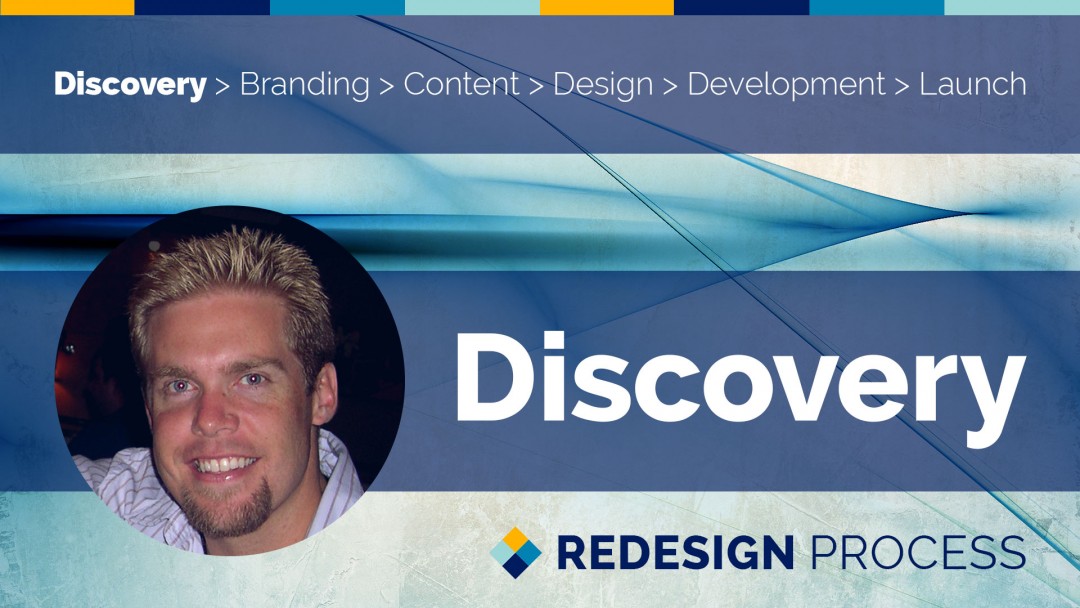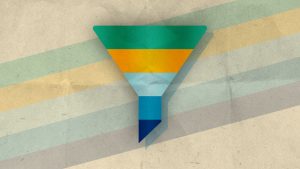25 reasons why Discovery is your friend
The Discovery phase is the first step in the redesign process. It sets the tone for your entire project and affects all aspects of your redesign. Discovery multiplies the effectiveness and profitability of your upgraded website. Let’s start with the top three reasons why Discovery is so smart:
- Leverage
Not all actions are equal. The Discovery phase is jam-packed with high-leverage activities. If you’re familiar with the 80/20 Rule, Discovery is part of the 20% that produces 80% of your results. This is where small decisions save production costs and multiply profits for years to come. - Preparation
Measure twice, cut once. Discovery is the part of your project that prepares blueprints and instructions for the hundreds of tasks and decisions ahead. Most expensive web design mistakes have roots in poor preparation. - Prevention
Problems are one thing, failure is a different beast. All project failures are preventable. You can’t avoid every pitfall but you can prevent failure.
“The beginning is the most important part of the work.” — Plato
Now for a quick backstory (and I promise this isn’t just about me). It’s important that you know you’re in good hands. So here are a few personal factoids:
- I’ve been a designer and developer since 1999
- 35,000+ hours of creative professional experience
- Career in interactive design and development (apps, games, and websites)
- Worked on approx. 120 interactive projects
- Flown solo and worked as part of large development teams
- Worked on multi-million dollar projects and quickies under $1,000
- Over 700 jobs as a freelance designer for small businesses
- Thousands of print design pieces as well
Enough about me. The point is that I’m well-versed in creative development and process optimization. And from many years of experience, I can tell you one thing for sure. There is no single process that always works best. The best methods for project workflow depend on variables that aren’t clear until after you greenlight a project. Then comes some digging and research before you know how to proceed after kick-off.
Generally, the first step of any web project is a Discovery or Concept phase. Designers and developers love Discovery. It helps them prepare, removes uncertainty and establishes direction. Small business owners enjoy it less. It’s an intrusive, expensive step that produces few tangible results. So it’s a tough financial pill to swallow. About 15-20% of the average project budget evaporates in early communication, analysis, problem-solving, definition, and planning.
While it produces skimpy deliverables, Discovery is the #1-factor impacting web project success.
First, almost every process breakdown or project failure is preventable. The right information upfront keeps problems from happening further down the pipeline. Next comes leverage. It’s a less obvious reason why Discovery is so important. Discovery done well is high-leverage activity. The problem-solving that occurs in Discovery is more impactful than anything that comes later.
Discovery is the #1-factor impacting web project success. Share on XBut wait, there’s more! It’s a disservice to Discovery to boil it down to preparation, prevention and leverage. How about 22 more reasons why Discovery is more important than it looks?
The Discovery phase fosters communication

In hindsight, the roots of nearly all production problems appear in Discovery. Most project difficulties are process-oriented or stem from miscommunication. In other words, doing the wrong thing in the wrong order because you’re working on the wrong problem. These are avoidable, preventable headaches. Communication is the key and Discovery is where it begins.
- Qualification
Not all clients and vendors are right for each other. The first step in the Discovery phase starts before making commitments. If you’re a small business looking for a web designer, you have the right to kick the tires. Qualify your potential vendor before moving forward. On the flip side, a service provider has an equal right to qualify a client before making a commitment. Something for everyone to keep in mind is that a fast no is better than a hesitant yes. So trust your gut when getting started and just say no if it doesn’t feel right. This is your opportunity to save everyone the hassle of a painful project. - Dialogue
For many reasons, projects suffer when they’re one-sided. It’s in everyone’s best interest to establish a mutual, consistent dialogue. Two heads are better than one and it’s dialogue that resolves a problem before it begins. It also prevents project lulls and delays. Dialogue keeps clients from micromanaging and designers from working on the wrong problems. And it naturally leads to collaboration. - Collaboration
All successful redesign projects are collaborations. The client provides valuable information, guidance, and feedback. The web designer contributes specialized knowledge and technical ability. When both sides work together, there aren’t actually sides but a new team. Teamwork and synergy are side-effects of collaboration that starts during Discovery. Collaboration continues to polish results as you progress through the next phases of your project. - Expectations and Assumptions
Many problems come from assumptions and undocumented expectations. Side comments and early brainstorming conversations might actually become undocumented project requirements. As details evolve during Discovery, it’s smart to write down and share your expectations. If it’s important, write it down and share it. Make sure everyone understands and is on the same page. - Sharing
The Discovery phase is full of information-rich discussions. Sharing information during Discovery keeps the project on track and improves the final product. Sharing information allows both parties to anticipate needs and avoid bottlenecks later in production.
“It’s so much easier to suggest solutions when you don’t know too much about the problem.” ― Malcolm Forbes
Discovery emphasizes analysis and research

Website redesign is generally analytical and logical before it gets creative. The majority of the research and analysis happens during Discovery. The Discovery phase unearths the connection between user behavior and your online business goals. Discovery analyzes real problems and makes logical decisions (rather than relying on creative instinct and intuition alone).
- Target audience
Have you ever heard of user-centered design? If not, it’s a major part of modern user experience design. User-centered design empowers the needs of the user to influence the design process. The idea is to begin with the end user in mind and tailor specific solutions for them. You can’t benefit from user-centered design principles if you don’t understand your target audience. It’s best to define your visitors before you make decisions that impact their experience. - User behavior
Before you can prescribe a solution, you have to diagnose what’s going on. User behavior is a great place to start. What are the current user actions, tasks, and behaviors? How do visitors currently use your site? Are they engaged? Understanding user behavior guides the steps you will take. It improves the redesigned site’s performance and user experience. - Online business goals
For small business websites, there aren’t a lot of competing online business goals. But certain goals such as lead generation and sales conversions take priority. Whatever your goals may be, it’s important that distinct user flows exist. User flows are channels that allow your visitors to accomplish tasks. They’re simple, logical steps that don’t require much thinking. - Existing problems
The reasons for redesign and actual, real problems are often different. You may be trying to solve a conversion rate problem by asking for more traffic. More revenue is the goal and the easy solution is to add more eyeballs to the problem. That’s an expensive solution that doesn’t solve anything. Often it’s far more effective to plug the leaks before shooting for extra traffic. - Friction points
Friction points are bumps along the conversion funnel that cause people to hesitate or jump ship. Addressing friction points is one of the highest leverage activities during Discovery. Where and why are people currently leaving your site? - The competition
There’s a good chance that if you designed your site three years ago, it’s been three years since you’ve looked at the competition. Creating a composite view of your top competitors is an excellent exercise. It generates content strategies and design direction for later in the redesign process. How are you going to beat the competition if you don’t know what they’re doing? - Trends and patterns
Analyzing the competition uncovers content, design and technology trends and patterns. It’s good practice to be aware of what people are familiar with and expect from a website in your industry.
“If I had an hour to solve a problem I’d spend 55 minutes thinking about the problem and 5 minutes thinking about solutions.” ― Albert Einstein
Discovery provides solutions to problems

The vast majority of redesign projects only address two fundamental problems. First, the problem of not generating enough business online. Second, the problem that your website doesn’t make you look good. It’s fascinating that these two simple problems generate so many unique solutions. So beware, don’t assume your solutions are more traffic, first on Google or a better website. Individual solutions are unique and different than common problems. One-size-fits-all solutions don’t exist.
- Brainstorming
Your first idea isn’t always your best idea. Discovery done right produces a menu of options before identifying the best solution for you. - Frame of reference
Creating a frame of reference is Design 101. If you don’t understand project parameters, you’re guaranteed to work on the wrong problem. - Actionable solutions
It’s not a problem worth your attention if there’s nothing you can do about it. Discovery focuses on solutions and actions that produce measurable results. - Impactful decisions
If you want efficiency, make smarter decisions earlier. The Discovery phase helps you make decisions and work smarter without working harder.
“By failing to prepare, you are preparing to fail.” ― Benjamin Franklin
Discovery prepares your project and helps you plan

Planning separates the amateurs from the pros. So many setbacks come from inadequate planning and poor preparation. Jumping into design and development without proper planning is an expensive lesson in wastefulness.
- Focus and simplicity
Discovery brings focus to a redesign project. Solutions are often simpler than you’d think. And without focus and clarity, it’s impossible to chart your course through the rest of your project. - Goals and challenges
Good planning requires clear-cut goals and knowledge of your unique challenges. It’s alarming how many projects begin with ambiguous goals and unknown difficulties lurking ahead. Planning during Discovery prevents unexplored obstacles from popping up later. - Scope and specs
No project stays within its budget without a scope outline and detailed specifications. How can you plan your project if you don’t understand the scope of the work? - Budget range and timelines
From a business owner’s point of view, this is where the conversation wants to begin. How much does it cost? Followed by… When will it be done? You’re in luck. The Discovery phase accurately addresses budget and timelines. Unfortunately, this isn’t the first step in the process. Providing accurate estimates requires a good amount of due diligence. This happens before establishing the squirrely variables of time and money. - Strategic planning
Strategic planning is simply prioritization and alignment of resources. It’s one thing to plan the sequence of work to be done. But add some dependencies to the mix and it’s smart to think about a shared strategy. Strategic planning focuses and organizes the efforts of the team. - Instructions
I may have saved the best for last. Planning during the Discovery phase provides instructions for the project ahead. These instructions are the blueprints that shave weeks off the schedule (and save thousands in production). Don’t jump into a redesign project without a written plan.







